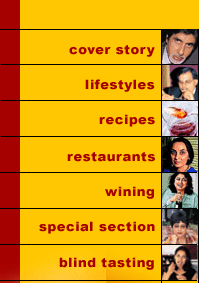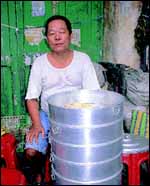



|
|
WELCOME to Calcutta�s Chinatown, to Dr. Sun Yat Sen Street, where ideally you should kick off your Chinese culinary journey at 6 o�clock in the morning. Yes, that early. The first rays of dawn will not have broken at that hour. Nor will the Calcutta Transport Corporation�s first trams be rumbling along cobbled roads.
But in Chinatown, steamers will be hissing, woks sizzling and chopsticks clicking against china bowls, as Chinese housewives in Mao tunics sell traditional breakfast foods to hungry citizens. Be warned, the breakfast will end at 8 o�clock. And unless you have friends among the inscrutable Chinese who will invite you home to tea, this is the only place in India where you can have a Chinaman�s breakfast. So go early.
Be guided by your nose. Or follow the Buddhist monks who have got there before you on rickshaws pulled by men with silent feet. They are having the all-time Chinese favourite. Sticky rice and glass noodles with jasmine tea. But there�s also dumplings stuffed with meat, shrimp and chicken. Plump Chinese bread centred with succulent diced pork. And piping hot soup floating with Chinese cabbage and the globules of fat from bones that went into its simmer.
Breakfast is cheap in Chinatown, as is most Chinese food, because it�s homemade and off the street. The food is served in faded melamine plates and the sauce bottles and soya jars could have been from the Ming era. But be of strong heart. You can have your fill and more, plus take a doggy bag home, for as little as Rs. 25.
The food is as sumptuous as it is filling, you will find. Bite into a platter of pork and prawn wontons, steamed or fried as your fancy dictates, or nibble delicately on a hunk of bean curd. And do sample the deep-fried patties of chicken wrapped in cabbage leaf. The roast duck and salted meats, you may pack up and take home, because it takes a Chinese stomach to feed on these first thing in the morning. But you could try the momos filled with fish, pork and chicken. They are light and airy. Have them with the chilli-garlic sauce. Yes, momos are Tibetan, but some Chinese call them momos, some say sui mai. They taste the same.
There�s a jasmine tea-seller on Dr. Sun Yat Sen Street too. This is where Chinatown�s senior gentry hang out most mornings. The tea is dark and aromatic, but the gossip is their favourite past-time. They love discussing Communism in the mainland, and reading Calcutta�s two Chinese morning newspapers, The Chinese Journal of India and the Overseas Commerce.
These have been in circulation since 1935 and 1969 respectively, and are published from Metcalf Street and South Tangra Road. Yes, by Chinese journalists, naturally. The newspapers give the 500-odd Chinese families in Calcutta a sense of identity. They serve as the one and only link with our Chinese past. And they report every Chinese birth, death and wedding in the city! The whole idea is to read them and not forget the Chinese language.
This Chinatown is located a little beyond Bow Bazaar, in between Chhitranjan Avenue and Bentick Street. The first Chinese who set foot on the shores of Bengal, Yong Atchew, did so with the specific purpose of settling down. Before him, monks and traders had come and gone, but Yong imposed himself upon the East India Company and Warren Hastings and got the migrant Chinese community in Bengal some land.
They set up Chinatown in 1799, the only one on the Indian subcontinent. The community was formed by restaurateurs, dentists, paper-flower makers, dry cleaners, shoe-makers, carpenters, astrologers and beautcians. They thrived with their own schools, clubs, morning markets, provision stores and eateries. Now a lot of Chinese have gone back to the mainland. Others have gone to America, Canada and Sweden. And, sadly, Chinatown comes alive in an open bazar only for those few hours in the morning.
The other Chinatown is towards the east of Calcutta, off the metropolitan bypass leading to the airport, and this area is called Tangra. It is where the Chinese-owned leather tanneries are located, and small food factories like Sing Chong that make chilli and soya sauce, and noodles. Seven, eight years ago, 75 per cent of Tangra�s tanneries shut down when environmentalists objected to the foul smell emanating from them.
The Chinese tried fighting against the city in court, but lost. So, most of them closed down the tanneries and opened restaurants there. Today, these Chinese restaurants have become Calcutta�s current gastronomic status symbol. You would have thought, going to Tangra was like going to the Royal Calcutta Golf Club. You can do so only if you are introduced to it by someone who has already been there. But if you can suppress the horror of getting inextricably lost in Tangra�s labyrinth of lanes, ignore the stink of uncured leather and chemical effluents, you will come to where the authentic flavour of Chinese cuisine really is in Calcutta.
I am an old Calcutta Chinaman. I was born in this city, adopted here by a kindly Chinese restaurateur, and I got my first lessons in cooking at the wok from an ancient Chinese cook who cracked my skull with a wooden spoon every time I confused the soya sauce with chilli. I am home in Calcutta�s Chinese settlements. I love their temples with ornate roofs, tiles, wooden artefacts and rare furniture, the ceremonial candles (lapchoks) and joss sticks burning before the altar of Kwanti.
I enjoy the traditional manner in which weddings and new years are celebrated here, the colourful festoons and dragon motifs, the rustle of Oriental silk embroidery textiles, the roar and clang of the lion dance. I am amused by their simple pleasures, the clitter-clatter of mahjonj tiles, the rowdy card games in the Chinese clubs. And I adore the exotic aromas of roast suckling, dried duck, Chinese sausages and jasmine tea that wafts out from open doors in these areas.
I am often asked which Chinese restaurant do I eat in when I go to Calcutta. I wish I could answer that... because there are so many restaurants in Tangra itself that serve the most amazing Chinese cuisine you can get in Calcutta. The Chinese families that run these restaurants do not specialise in any particular school of cooking. So if you are hoping to get a Szechuan meal there, or, perhaps, Cantonese, forget it. You might find, instead, the food spicy hot... as they make it in Hunan province of China!
This is because the Chinese chefs at Tangra cook their food like they are cooking at home. But they modify the cooking. They add the spices we would not otherwise use in Chinese food. And they do this for the Bengali customers who make up 90 per cent of their clientele in Calcutta. I would not be able to eat this kind of food. So, when I go to Calcutta, I go to some Chinaman�s home. And he orders the food from a restaurant for me. But it is Chinese-Chinese food. None of your ginger and garlic in it! This food is something else.
|

Home Page
About the mag
Subscribe
Advertise
Contact Us